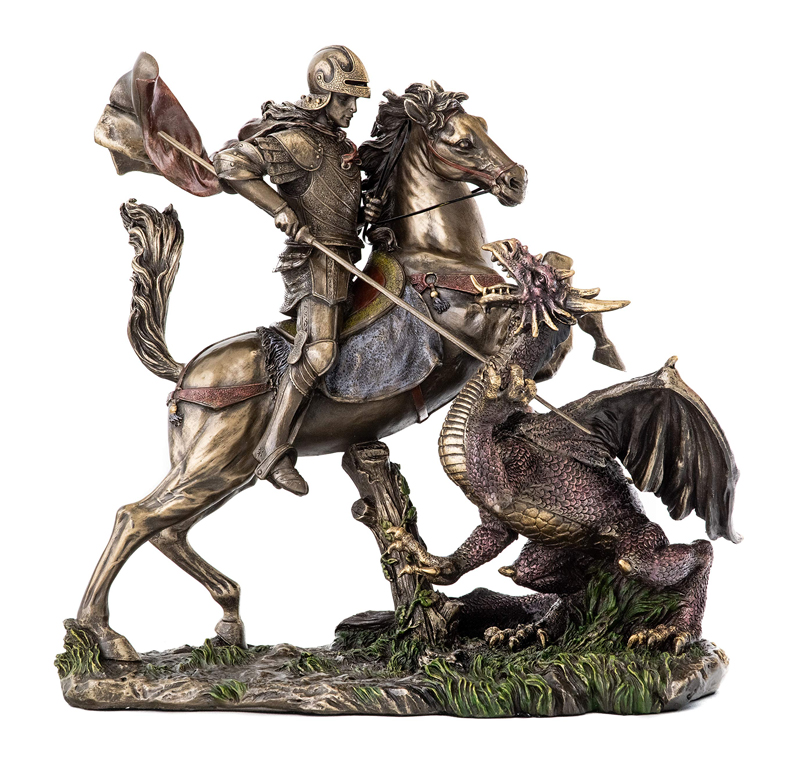Legendary Medieval Knight George Slaying the Dragon Statue
Legendary Medieval Knight Statue premium sculpted cold-cast bronze with real bronze powder mixed with resin. Hand-painted color accents on the bronze finish to give a high-quality antique look without sacrificing the details. The intricate craftsmanship of this statue is simply breathtaking. Painted and illustrated by countless artists from the Crusades to the Renaissance, the legend of St. George and the Dragon is modeled wonderfully in this recreation. The attention to detail in the armor, the horse, and the dragon is exceptional. The hand-painted color accents elevates this from a simple bronze statue to a true work of art. The origins of this legend vary, some say that St. George was a Roman soldier, a Crusader knight, or possibly pre-Christianity myths. In this version, St. George slays the Dragon that is terrorizing a town in Libya, and the lord sacrifices his only daughter as tribute. George kills the dragon, saves the princess, and converted the city to Christianity. The legend of Saint George and the Dragon tells of Saint George (died 303) taming and slaying a dragon that demanded human sacrifices.
The story goes that the dragon originally extorted tribute from villagers. When they ran out of livestock and trinkets for the dragon, they started giving up a human tribute once a year. This was acceptable to the villagers until a well-loved princess was chosen as the next offering. The saint thereupon rescues the princess chosen as the next offering. The narrative was first set in Cappadocia in the earliest sources of the 11th and 12th centuries, but transferred to Libya in the 13th-century Golden Legend. The narrative has pre-Christian origins (Jason and Medea, Perseus and Andromeda, Typhon, etc.), and is recorded in various saints’ lives prior to its attribution to St. George specifically. It was particularly attributed to Saint Theodore Tiro in the 9th and 10th centuries, and was first transferred to Saint George in the 11th century. The oldest known record of Saint George slaying a Dragon is found in a Georgian text of the 11th century. The legend and iconography spread rapidly through the Byzantine cultural sphere in the 12th century. It reached Western Christian tradition still in the 12th century, via the crusades.
The knights of the First Crusade believed that St. George, along with his fellow soldier-saints Demetrius, Maurice and Theodore, had fought alongside them at Antioch and Jerusalem. The legend was popularised in Western tradition in the 13th century based on its Latin versions in the Speculum Historiale and the Golden Legend. At first limited to the courtly setting of Chivalric romance, the legend was popularised in the 13th century and became a favourite literary and pictorial subject in the Late Middle Ages and Renaissance, and it has become an integral part of the Christian traditions relating to Saint George in both Eastern and Western tradition. The iconography of military saints Theodore, George and Demetrius as horsemen is a direct continuation of the Roman-era “Thracian horseman” type iconography. The iconography of the dragon appears to grow out of the serpent entwining the “tree of life” on one hand, and with the draco standard used by late Roman cavalry on the other.
Horsemen spearing serpents and boars are widely represented in Roman-era stelae commemorating cavalry soldiers. A carving from Krupac, Serbia, depicts Apollo and Asclepius as Thracian horsemen, shown besides the serpent entwined around the tree. Another stele shows the Dioscuri as Thracian horsemen on either side of the serpent-entwined tree, killing a boar with their spears. The development of the hagiographical narrative of the dragon-fight parallels the development of iconography. It draws from pre-Christian dragon myths. The Coptic version of the Saint George legend, edited by E. A. Wallis Budge in 1888, and estimated by Budge to be based on a source of the 5th or 6th century, names “Governor Dadianus“, the persecutor of Saint George as “the dragon of the abyss“. A greek myth with similar elements of the legend is the battle between Bellerophon and the Chimera. Legendary Medieval Knight George Slaying the Dragon Statue sizes: 13.5 inches / 34 cm x 7.6 inches / 19 cm x 13.8 inches / 35 cm.
Legendary Medieval Knight Statue on Amazon.
Legendary Medieval Knight Statue on eBay.
Medieval Statues and Dragons Statues.



